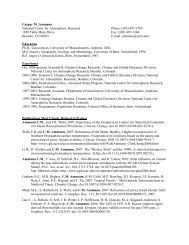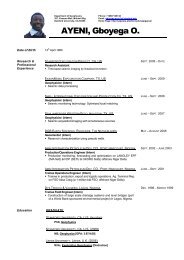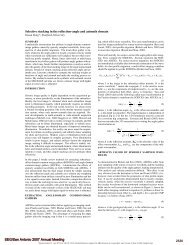pdf 349K - Stanford Exploration Project - Stanford University
pdf 349K - Stanford Exploration Project - Stanford University
pdf 349K - Stanford Exploration Project - Stanford University
Create successful ePaper yourself
Turn your PDF publications into a flip-book with our unique Google optimized e-Paper software.
SEP–108 Integrated velocity estimation 3<br />
LEAST SQUARES FORMULATION<br />
The fundamental data unit of this paper is the “time/depth pair”, which is quite simply the<br />
traveltime of seismic waves to a specified depth, along an assumed vertical raypath. We denote<br />
time depth pairs by (τp,ζp), indexed by p, the “pair” index. The output velocity function is<br />
linear within layers. We denote layer boundaries, which are independent of the time/depth<br />
pairs, by tl, indexed by l, the “layer” index. We begin by deriving the 1-D data residual – the<br />
depth error between the depth component of a time/depth pair (ζp) and its time component<br />
(τp) after vertical stretch with the (unknown) interval velocity:<br />
ep = ζp −<br />
� τp<br />
0<br />
v(t)dt. (1)<br />
For implementation purposes, we break the integral into the sum of integrals between neighboring<br />
time/depth pairs (t = [τp,τp+1]):<br />
ep = ζp −<br />
p�<br />
q=1<br />
� τq<br />
τq−1<br />
We assume that the interval velocity in layer l is linear,<br />
v(t)dt. (2)<br />
v(t) = v0,l + klt; {t = [tl,tl+1]}, (3)<br />
so the integral in equation (2) has a closed form. To obtain a correspondence between time/depth<br />
pairs and layer boundaries, note that, given a time/depth pair, we can always determine in<br />
which layer it resides. In other words, we can unambiguously write l as a function of p, l[p].<br />
Now we can evaluate the integrals of equation (2):<br />
ep = ζp −<br />
p�<br />
q=1<br />
v0,l[q](τq+1 − τq) + kl[q]<br />
2 (τ 2 q+1 − τ 2 q ). (4)<br />
Equation (4) defines the misfit for a single time/depth pair, as a function of the model parameters<br />
2 . Now pack the individual misfits from equation (4) into a residual vector, rd:<br />
�<br />
v0<br />
rd = ζ − A<br />
k<br />
�<br />
≈ 0 (5)<br />
The elements of vector ζ are the time/depth pair depth values, A is the summation operator<br />
suggested by equation (4). and [v0 k] T is the unknown vector of intercept and slope parameters.<br />
The primary goal of least squares optimization is to minimize the mean squared error of<br />
the data residual, hence the familiar fitting goal (≈) notation.<br />
2 Equation (4) implictly assumes that layer boundaries do not occur between time/depth pairs. The code<br />
does not make this assumptions: layer boundaries can occur anywhere in time, and are completely independent<br />
of the time/depth pairs. When a layer boundary lies between time/depth pairs p and p + 1, the integral<br />
has two parts: depth contribution from above and below the layer boundary.







